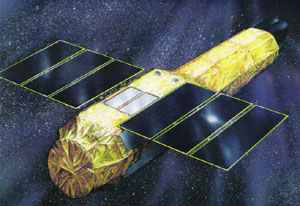|
|
Astro-E

ASTRO-E was to be the Japan’s fifth X-ray astronomy
mission, but was unfortunately lost during launch (10 Feb 2000).
Astro-E was developed at the Japanese
Institute of Space and Astronautical Science (ISAS) in collaboration
with the US and Japanese institutions.
Astro-E was to carry, among other instruments, a new type
of X-ray spectrometer, the X-ray micro-calorimenter, which provides an
unprecendent energy resolution compared to non-dispersive instruments.
The mission was rebuild as ASTRO-E2, renamed Suzaku, that was successfully
launched in 2005 and operated for 10 years.
Mission Characteristics
 Lifetime : early 2000 - (XRS has a 2 year lifetime)
Lifetime : early 2000 - (XRS has a 2 year lifetime)
 Energy Range : 0.4-700 keV
Energy Range : 0.4-700 keV
 Special Features
: First X-ray micro-calorimeter in space
Special Features
: First X-ray micro-calorimeter in space
 Payload :
Payload :
- Five nested conical thin-foil grazing incidence telescopes (XRT),
with a spacial resolution of < 1.5´. Four telescopes
are gold-coated (XRT-I) and one is platinum-coated (XRT-S).
At the focus of each telescope there is one of the following detectors :
- X-ray Spectrometer (XRS; 0.4-10 keV; one unit)
It is X-ray micro-calorimeter composite of 32 pixels
at the foci of the XRT-S.
Energy resolution ~12 eV at 6 keV.
FOV 2´ X 4´
- X-ray Imaging Spectrometer (XIS; 0.4-10 keV; four units)
Each units is a 1024 X 1024 pixel CCD detector
at the foci of one XRT-I.
FOV 19´ X 19´, eff. area per each 300 cm2 @
1 keV, energy resolution 130 eV (E/6keV)1/2
- Hard X-ray Detector (HXD; 10-700 keV)
GSO Phoswich counters (> 50 keV) & silicon PIN diodes (< 50 keV)
FOV 0.8° @60keV and 2.8° @500keV
eff. area (<40 keV) 230 cm2 (<40 keV) , 330cm
2
(> 40 keV)
energy resolution 3 keV @ 10 keV, 9% @ 662 keV
[Suzaku/Astro-E2 Guest Observer Facility]
[All Missions]
[by Time]
[by Energy]
Page authors: Lorella Angelini Jesse Allen
HEASARC Home |
Observatories |
Archive |
Calibration |
Software |
Tools |
Students/Teachers/Public
Last modified: Thursday, 24-Sep-2020 18:05:00 EDT
|


